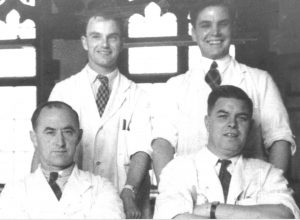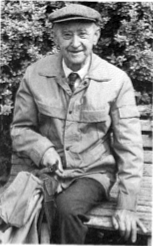Self-taught Bristol-based geologist, who worked as a palaeontological technician for the University of Bristol from 1947 to 1968.
Tom Fry was a self-taught geologist who spent every spare moment cycling around the Bristol area, and further afield, to observe geology and improve his understanding. He had an amazing eye for fossil finding, and amassed several noted collections which he had to sell to the Bristol City Museum and the Department of Geology at the University of Bristol at various times.
Fry left school at the age of 13 and took a variety of labouring jobs, including working as a laundry delivery lad, in a chocolate factory, a wagon works, a plant nursery, a chemical plant, a cycle maker’s, and a quarry. In 1930, and at other times, he was unemployed and was desperate for income to support his wife and family. In 1934, Arthur Trueman paid him £75 for his collection of local rocks and fossils, a very welcome sum of money that helped tide Fry through a tough time of unemloyment.
All the time, and despite real privation, Fry maintained his obsession with geology, sometimes cycling as far as 50 miles from home, and sleeping out in fields on his longer treks. He kept extensive notebooks, having attended lectures and evening courses, and taught himself how to make geological observations. He lived all his life in St George in the east of the city, an area of active coal mining, quarrying, and lead smelting, early in the twentieth century, and he made meticulous and valuable notes and sketches of all he saw of these long-lost industries. Between 1919 and 1923, he recorded that he embarked on 742 fossil-hunting excursions.
 Technical staff of the Department of Geology in the late 1950s, showing Tom Fry (front left) and Edward Seavill (front right), and behind them Maurice White (left) and George Bryant.
Technical staff of the Department of Geology in the late 1950s, showing Tom Fry (front left) and Edward Seavill (front right), and behind them Maurice White (left) and George Bryant.
Fry attracted the notice of more fortunate citizens of Bristol with geological interests, including three of the Bristol professors, Sidney H. Reynolds, Arthur E. Trueman, and Walter F. Whittard. And indeed, after working as a labourer in Whittard’s garden and as a trench digger, he received a remarkable offer from Whittard in 1947: he was offered a post as a technician in the Geology Department, at £5 per week. The work, as Whittard described it was to act essentially as his fossil collector, and this was the dream job, eventually, for a many of Fry’s passion and ability.

Through this span of time, Fry was encouraged to continue his travels around the Bristol area collecting fossils, and he then donated all his finds to the growing collections in the Department of Geology. He was also sent further afield, to spend whole months collecting fossils for Whittard’s studies in the Ordovician of the Welsh Borders. For his efforts, two trilobites were named after him, Amphilichas fryi by Whittard in 1956 and Piltonia fryi by Roland Goldring in 1958. During the 1950s, Fry also devoted immense effort to setting the Department’s fossil collections in order, making sure they had proper labels recording all the necessary information, labels that still exist today.
When he retired in 1968, Tom Fry was awarded an Honorary MA by the University of Bristol, an honour that gave him immense, but quiet, satisfaction. From 1968 to 1980, Fry worked for Bristol City Museum, continuing to collect fossils, which he donated to the Museum, together with his notebooks. He remained active even at the age of 90 (photograph right).
Read more
Carpenter, S. 1997. Thomas Robert Fry 1902-1997. Proceedings of the Bristol Naturalists’ Society 57, 19-20.
Crane, M.D. 1980. Collections and collectors of note. 34. T.R. Fry. An annotated list of material in the City of Bristol Museum & Art Gallery collected by T.R. Fry. The Geological Curator 2, 563-571. Read this paper here.
Large N. 1994. Tom Fry, the fossil finder. The Countryman, Winter, pp. 95–100.

